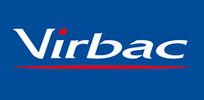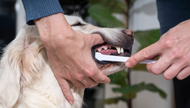The Ultimate Guide for Dog Teeth Cleaning
Posted by Virbac -
We all know how important it is to keep our own teeth clean and healthy. But did you know that daily teeth cleaning is just as important for your dog? Just like us, dogs can experience dental conditions like plaque and tartar build up as well as gum disease if their teeth aren’t cleaned. The World Small Animal Veterinary Association (WSAVA) Global Dental Guidelines reports that 80% of dogs will have some form of periodontal disease by the time they’re two years old!
Read on to find out why a regular dog dental cleaning routine is vital, how you can help to prevent dog dental diseases, and what to look out for, starting with the most common sign…
Understanding Dog Bad Breath
There’s a common misconception that bad breath in dogs is just a fact of life, but as with humans, bad breath is not the norm for our canine companions. “Doggy breath” can simply be due to eating strong-smelling foods, but it may be a sign of a condition that needs professional attention, such as:
- Dental disease e.g. periodontal disease
- Inflammation of the soft tissue of the mouth (stomatitis)
- An infected lump or mass in the mouth
- Airway infections
- Digestive problems including vomiting, reflux
- Systemic disease including kidney disease, liver disease, diabetes
Dog Bad Breath and Dental Disease
Dental disease is the most common cause of bad breath in dogs. It’s caused by plaque, a bacteria-laden substance that sticks to your dog’s teeth. If plaque is not removed daily with teeth cleaning it can quickly build up on the teeth and around the gum line, causing dental and gum diseases. Eventually, it can lead to loosening or even loss of the teeth.
Dental and gum diseases can be painful for dogs! This may cause difficulty eating, loss of appetite, irritability, and reduced quality of life. The bacteria responsible for gum disease can also spread beyond the mouth, affecting the heart, kidney and liver. It is therefore important to have your dog’s mouth regularly checked by your vet.
Dog Teeth Cleaning At Home
The best way to keep your dog’s teeth clean is with daily brushing. Human toothpastes contain ingredients that might be harmful to your dog, so it’s important to use a toothpaste designed especially for dogs to brush their teeth. Choose a pet-safe toothpaste with a dog-friendly flavour, such as our Enzymatic Toothpastes.
It’s also better to use a special dog toothbrush, such as the Dual-Ended Toothbrush. Their smaller heads, slimmer handles, and softer bristles are ideally angled to fit the canine mouth, giving your dog’s teeth a thorough but comfortable clean.
A Step-By-Step Guide to Brushing Your Dog’s Teeth
Step 1: Build tolerance gradually
Introduce teeth cleaning gradually, ideally from the puppy stage. Start by gently stroking your dog’s cheek and muzzle to get them used to having your hands near their mouth. Once they’re comfortable, try gently slipping your finger beneath your dog’s lip, and then rubbing your finger along the teeth and gums. It may take days or weeks to progress through each stage; don’t be tempted to rush, as moving too quickly might make your dog anxious.
Step 2: Introduce the toothpaste and toothbrush
Let your dog taste the toothpaste by licking a small amount from your finger. Next, try rubbing some along their teeth and gums with your finger. If they’re happy with this, you can then let them lick the toothpaste from the toothbrush. Enzymatic Toothpastes are poultry or fish flavoured to facilitate the brushing experience, so you should have no trouble finding a flavour your dog loves!
TIP: If your dog won’t tolerate a standard dog toothbrush try cleaning their teeth with your fingers using clean gauze or a finger brush, found in our Oral Hygiene Kit.
Step 3: Get comfortable
Before you start brushing, it’s important to make sure your dog is as relaxed as possible. Sit in a comfortable position that allows you to lightly contain (but not restrain) your dog while still reaching their mouth. From the side, wrap your arm around your dog and gently hold their muzzle in one hand, being careful not to apply too much pressure.
TIP: Give your dog lots of reassurance and praise throughout, and reward them at the end with a treat.
Step 4: Start brushing your dog’s teeth
First, let your dog lick some toothpaste from the brush, then gently lift the lips to expose the teeth. Holding the toothbrush at a 45-degree angle, move it across the teeth and the gum line in light, circular motions, covering every tooth surface. If you’re finding it hard to reach the back teeth, try giving your dog a small toy to hold between their front teeth.
TIP: Keep it short and end the session before your dog gets restless, as they might otherwise learn that wriggling or struggling is an effective way to avoid teeth cleaning.
Professional Dog Teeth Cleaning
At least once a year or any time you notice a change in your dog’s breath, it’s a good idea to make an appointment with your vet to get to the root of the problem. You should also make an appointment if your dog has any of the following signs that may suggest dental disease:
- Yellow, brown or grey tooth discoloration (possible plaque or tartar build-up)
- Loose or lost teeth
- Red, swollen and/or bleeding gums (gingivitis)
- Appearing to be in pain
- Rubbing or pawing at their mouth
- Struggling to eat or refusing food
- Drooling excessively
- Weight loss
- Change of behaviour e.g. becoming more aggressive
After examining your dog’s mouth your vet may recommend a professional cleaning under anaesthesia to remove plaque and tartar. If there are any concerns on the teeth or gum, an X-ray may be necessary to evaluate the extent of the damages and other treatments (like root planning or extraction) may be advised if indicated.
A regular professional dental clean is an opportunity for your vet to spot any dental problems early, avoiding more invasive and costly treatments later on.
Preventing Dog Dental Problems
After a professional cleaning, the best way to keep your dog’s teeth and mouth healthy is to take a pro-active approach to dental hygiene. Although daily tooth brushing remains the best to help keep dental problems away, the following dog dental care methods can also help.
Dog dental chews
Dental chews can be useful for keeping plaque under control. Their abrasive texture dislodges bacteria and plaque from the teeth, and stimulates saliva to wash it away. Not all dog dental chews have the same efficacy. Choose one that is recommended by vets and that have proven efficacy, like our VeggieDent® FR3SH Dental Chews: with triple action that ensures fresh breath, reduces tartar and plaque thanks to their unique Z-shape that allows the chew to clean hard-to-reach teeth, as well as containing a prebiotic to target gastrointestinal causes of bad breath. What’s more, these tasty treats are free of animal-derived ingredients and come in four different sizes to suit every dog.
Keep the following tips in mind when choosing a dog dental chew:
- Choose the correct size to avoid a possible choking hazard and respect the recommendations (usually one chew per day)
- Choose a chew recommended by vets
- Avoid very hard chews as they may damage the teeth
Dry food
As with dental chews, the rough texture of dry food can help to clean your dog’s teeth. Ask your vet for advice on choosing the best dry dog food for dental health and incorporating it into your dog’s diet.
Water additives
A water additive is a liquid solution that can be added to your dog’s drinking water. Products like Aquadent® FR3SH® Dental Solution can help to freshen your dog’s breath, control odour-causing bacteria, limit plaque build-up and keep the gums healthy.
Banish “dog breath” for good!
The most effective way to keep your dog’s teeth clean and healthy is to provide daily oral hygiene and schedule regular check-ups with your vet. Bad breath may be a sign that you need to see your vet sooner, but don’t worry — if it’s still at an early stage, they can help you to get your dog’s oral health back on track and banish “dog breath” for good! If you’re unsure about the best dental hygiene routines and products for your dog, they’ll be happy to answer your questions and offer you their expert advice.


